2009 CHEVROLET TRAVERSE service
[x] Cancel search: servicePage 402 of 422
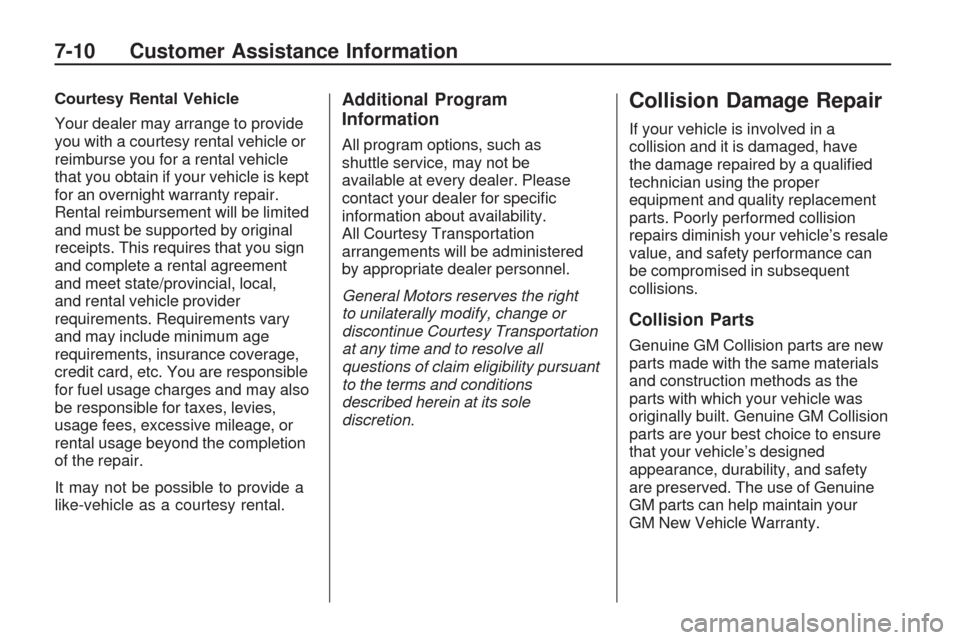
Courtesy Rental Vehicle
Your dealer may arrange to provide
you with a courtesy rental vehicle or
reimburse you for a rental vehicle
that you obtain if your vehicle is kept
for an overnight warranty repair.
Rental reimbursement will be limited
and must be supported by original
receipts. This requires that you sign
and complete a rental agreement
and meet state/provincial, local,
and rental vehicle provider
requirements. Requirements vary
and may include minimum age
requirements, insurance coverage,
credit card, etc. You are responsible
for fuel usage charges and may also
be responsible for taxes, levies,
usage fees, excessive mileage, or
rental usage beyond the completion
of the repair.
It may not be possible to provide a
like-vehicle as a courtesy rental.Additional Program
Information
All program options, such as
shuttle service, may not be
available at every dealer. Please
contact your dealer for speci�c
information about availability.
All Courtesy Transportation
arrangements will be administered
by appropriate dealer personnel.
General Motors reserves the right
to unilaterally modify, change or
discontinue Courtesy Transportation
at any time and to resolve all
questions of claim eligibility pursuant
to the terms and conditions
described herein at its sole
discretion.
Collision Damage Repair
If your vehicle is involved in a
collision and it is damaged, have
the damage repaired by a quali�ed
technician using the proper
equipment and quality replacement
parts. Poorly performed collision
repairs diminish your vehicle’s resale
value, and safety performance can
be compromised in subsequent
collisions.
Collision Parts
Genuine GM Collision parts are new
parts made with the same materials
and construction methods as the
parts with which your vehicle was
originally built. Genuine GM Collision
parts are your best choice to ensure
that your vehicle’s designed
appearance, durability, and safety
are preserved. The use of Genuine
GM parts can help maintain your
GM New Vehicle Warranty.
7-10 Customer Assistance Information
Page 404 of 422
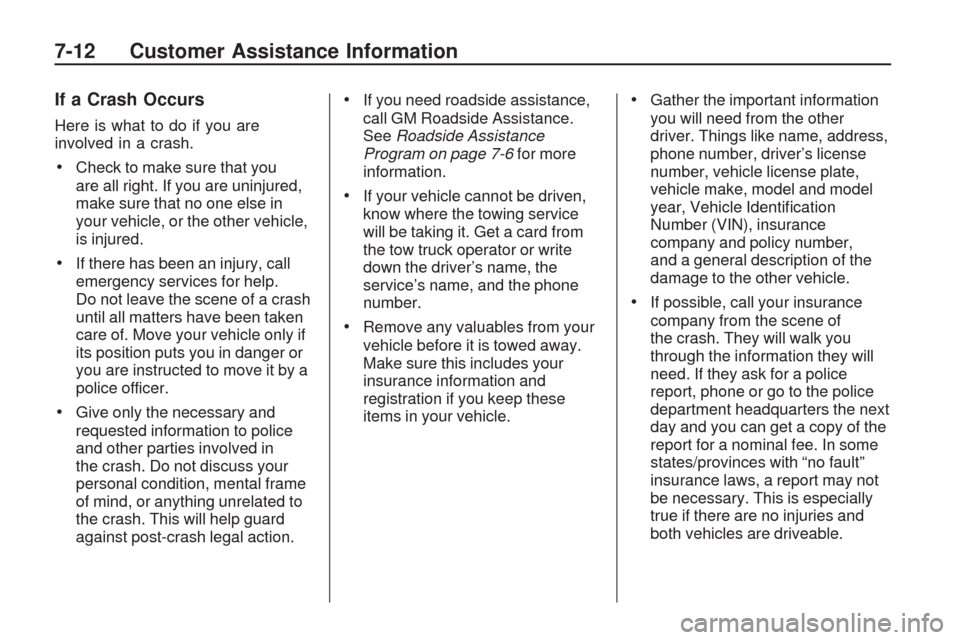
If a Crash Occurs
Here is what to do if you are
involved in a crash.
Check to make sure that you
are all right. If you are uninjured,
make sure that no one else in
your vehicle, or the other vehicle,
is injured.
If there has been an injury, call
emergency services for help.
Do not leave the scene of a crash
until all matters have been taken
care of. Move your vehicle only if
its position puts you in danger or
you are instructed to move it by a
police officer.
Give only the necessary and
requested information to police
and other parties involved in
the crash. Do not discuss your
personal condition, mental frame
of mind, or anything unrelated to
the crash. This will help guard
against post-crash legal action.
If you need roadside assistance,
call GM Roadside Assistance.
SeeRoadside Assistance
Program on page 7-6for more
information.
If your vehicle cannot be driven,
know where the towing service
will be taking it. Get a card from
the tow truck operator or write
down the driver’s name, the
service’s name, and the phone
number.
Remove any valuables from your
vehicle before it is towed away.
Make sure this includes your
insurance information and
registration if you keep these
items in your vehicle.
Gather the important information
you will need from the other
driver. Things like name, address,
phone number, driver’s license
number, vehicle license plate,
vehicle make, model and model
year, Vehicle Identi�cation
Number (VIN), insurance
company and policy number,
and a general description of the
damage to the other vehicle.
If possible, call your insurance
company from the scene of
the crash. They will walk you
through the information they will
need. If they ask for a police
report, phone or go to the police
department headquarters the next
day and you can get a copy of the
report for a nominal fee. In some
states/provinces with “no fault”
insurance laws, a report may not
be necessary. This is especially
true if there are no injuries and
both vehicles are driveable.
7-12 Customer Assistance Information
Page 407 of 422

Service Publications
Ordering Information
Service Manuals
Service Manuals have the diagnosis
and repair information on engines,
transmission, axle suspension,
brakes, electrical, steering, body, etc.
Service Bulletins
Service Bulletins give additional
technical service information needed
to knowledgeably service General
Motors cars and trucks. Each bulletin
contains instructions to assist in
the diagnosis and service of your
vehicle.
Owner Information
Owner publications are written
speci�cally for owners and intended
to provide basic operational
information about the vehicle.The owner manual includes the
Maintenance Schedule for all
models.
In-Portfolio: Includes a Portfolio,
Owner Manual, and Warranty
Booklet.
RETAIL SELL PRICE:
$35.00 (U.S.) plus processing fee
Without Portfolio: Owner
Manual only.
RETAIL SELL PRICE:
$25.00 (U.S.) plus processing fee
Current and Past Model
Order Forms
Technical Service Bulletins and
Manuals are available for current
and past model GM vehicles.
To request an order form, specify
year and model name of the vehicle.ORDER TOLL FREE:
1-800-551-4123 Monday-Friday
8:00 AM - 6:00 PM Eastern Time
For Credit Card Orders Only
(VISA-MasterCard-Discover), visit
Helm, Inc. on the World Wide
Web at: helminc.com
Or you can write to:
Helm, Incorporated
P.O. Box 07130
Detroit, MI 48207
Prices are subject to change
without notice and without incurring
obligation. Allow ample time for
delivery.
Note to Canadian Customers: All
listed prices are quoted in U.S.
funds. Canadian residents are to
make checks payable in U.S. funds.
Customer Assistance Information 7-15
Page 408 of 422
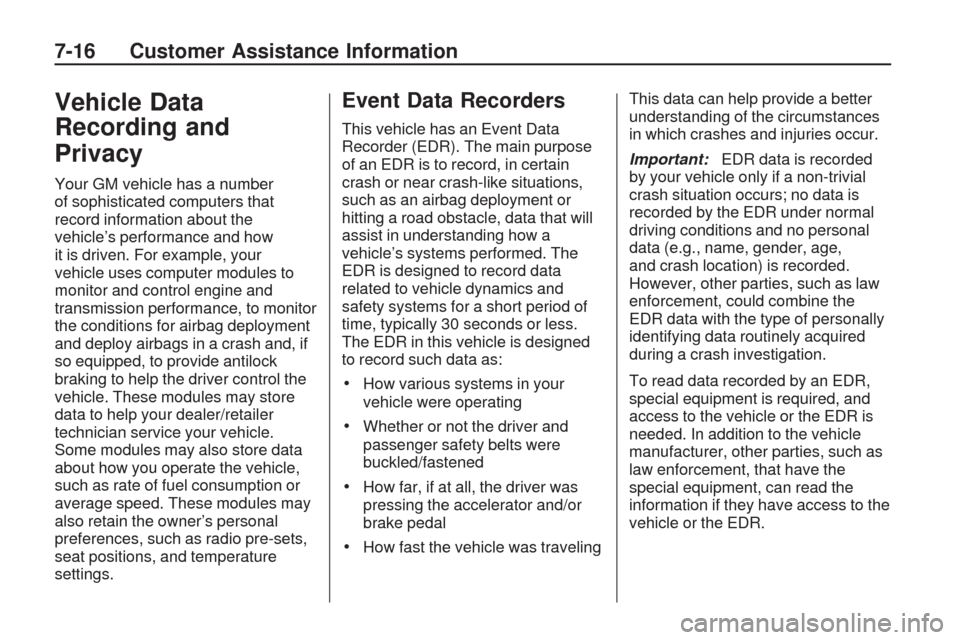
Vehicle Data
Recording and
Privacy
Your GM vehicle has a number
of sophisticated computers that
record information about the
vehicle’s performance and how
it is driven. For example, your
vehicle uses computer modules to
monitor and control engine and
transmission performance, to monitor
the conditions for airbag deployment
and deploy airbags in a crash and, if
so equipped, to provide antilock
braking to help the driver control the
vehicle. These modules may store
data to help your dealer/retailer
technician service your vehicle.
Some modules may also store data
about how you operate the vehicle,
such as rate of fuel consumption or
average speed. These modules may
also retain the owner’s personal
preferences, such as radio pre-sets,
seat positions, and temperature
settings.
Event Data Recorders
This vehicle has an Event Data
Recorder (EDR). The main purpose
of an EDR is to record, in certain
crash or near crash-like situations,
such as an airbag deployment or
hitting a road obstacle, data that will
assist in understanding how a
vehicle’s systems performed. The
EDR is designed to record data
related to vehicle dynamics and
safety systems for a short period of
time, typically 30 seconds or less.
The EDR in this vehicle is designed
to record such data as:
How various systems in your
vehicle were operating
Whether or not the driver and
passenger safety belts were
buckled/fastened
How far, if at all, the driver was
pressing the accelerator and/or
brake pedal
How fast the vehicle was travelingThis data can help provide a better
understanding of the circumstances
in which crashes and injuries occur.
Important:EDR data is recorded
by your vehicle only if a non-trivial
crash situation occurs; no data is
recorded by the EDR under normal
driving conditions and no personal
data (e.g., name, gender, age,
and crash location) is recorded.
However, other parties, such as law
enforcement, could combine the
EDR data with the type of personally
identifying data routinely acquired
during a crash investigation.
To read data recorded by an EDR,
special equipment is required, and
access to the vehicle or the EDR is
needed. In addition to the vehicle
manufacturer, other parties, such as
law enforcement, that have the
special equipment, can read the
information if they have access to the
vehicle or the EDR.
7-16 Customer Assistance Information
Page 409 of 422
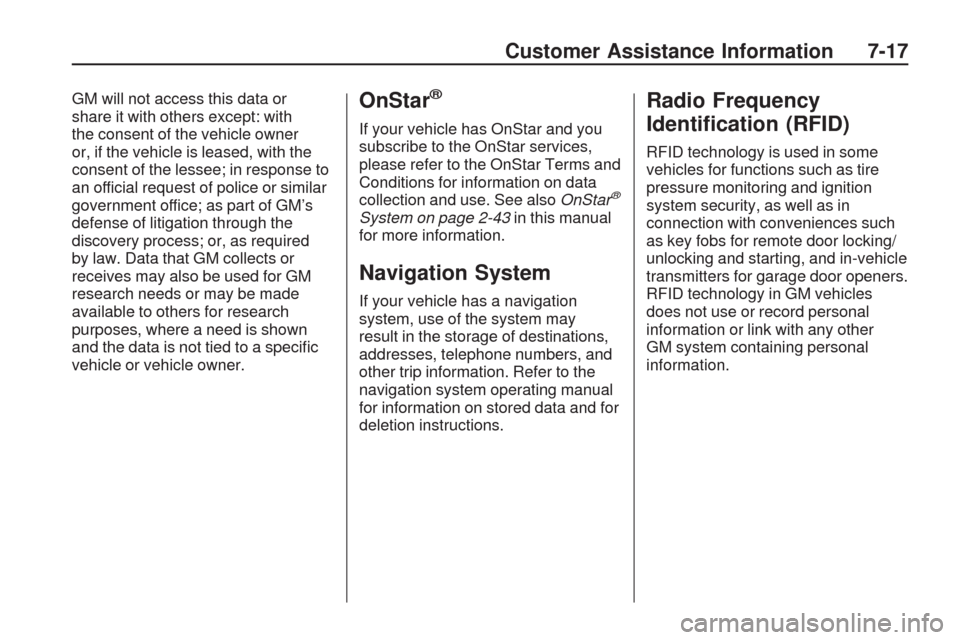
GM will not access this data or
share it with others except: with
the consent of the vehicle owner
or, if the vehicle is leased, with the
consent of the lessee; in response to
an official request of police or similar
government office; as part of GM’s
defense of litigation through the
discovery process; or, as required
by law. Data that GM collects or
receives may also be used for GM
research needs or may be made
available to others for research
purposes, where a need is shown
and the data is not tied to a speci�c
vehicle or vehicle owner.OnStar®
If your vehicle has OnStar and you
subscribe to the OnStar services,
please refer to the OnStar Terms and
Conditions for information on data
collection and use. See alsoOnStar
®
System on page 2-43in this manual
for more information.
Navigation System
If your vehicle has a navigation
system, use of the system may
result in the storage of destinations,
addresses, telephone numbers, and
other trip information. Refer to the
navigation system operating manual
for information on stored data and for
deletion instructions.
Radio Frequency
Identi�cation (RFID)
RFID technology is used in some
vehicles for functions such as tire
pressure monitoring and ignition
system security, as well as in
connection with conveniences such
as key fobs for remote door locking/
unlocking and starting, and in-vehicle
transmitters for garage door openers.
RFID technology in GM vehicles
does not use or record personal
information or link with any other
GM system containing personal
information.
Customer Assistance Information 7-17
Page 411 of 422

A
Accessories and
Modi�cations...................... 5-3
Accessory Power.................2-22
Accessory Power Outlets......3-17
Adding Equipment to Your
Airbag-Equipped Vehicle....1-58
Additional Required Services,
Scheduled Maintenance....... 6-6
Additives, Fuel...................... 5-5
Add-On Electrical
Equipment.......................5-86
Air Cleaner/Filter, Engine.......5-15
Air Conditioning...................3-19
Airbag
Readiness Light................3-33
Airbag System.....................1-46
Adding Equipment to
Your Airbag-Equipped
Vehicle........................1-58
How Does an Airbag
Restrain?.....................1-51
Passenger Sensing
System........................1-53
Servicing Your
Airbag-Equipped
Vehicle........................1-57Airbag System (cont.)
What Makes an Airbag
In�ate?........................1-51
What Will You See After
an Airbag In�ates?........1-51
When Should an Airbag
In�ate?........................1-49
Where Are the Airbags?.....1-48
Airbags
Passenger Status
Indicator.......................3-33
All-Wheel-Drive (AWD)
System............................. 4-7
Antilock Brake System (ABS) . . . 4-4
Warning Light...................3-37
Appearance Care
Aluminum or
Chrome-Plated Wheels . . . 5-83
Care of Safety Belts..........5-80
Chemical Paint Spotting.....5-84
Cleaning Exterior
Lamps/Lenses...............5-81
Fabric/Carpet...................5-79
Finish Care......................5-81
Finish Damage.................5-84
Instrument Panel, Vinyl,
and Other Plastic
Surfaces......................5-80Appearance Care (cont.)
Interior Cleaning...............5-78
Leather...........................5-80
Sheet Metal Damage........5-84
Tires...............................5-83
Underbody Maintenance....5-84
Washing Your Vehicle........5-81
Weatherstrips...................5-81
Windshield, Backglass,
and Wiper Blades..........5-82
Assistance Program,
Roadside.......................... 7-6
Audio System......................3-73
Audio Steering Wheel
Controls.....................3-125
Navigation/Radio
System, see
Navigation Manual.......3-103
Setting the Clock..............3-74
Audio System(s)..................3-75
Audio Systems
Radio Reception.............3-126
Rear Seat (RSA).............3-123
Theft-Deterrent Feature....3-125
Automatic Transmission
Fluid...............................5-16
Operation........................2-24
INDEX i-1
Page 413 of 422
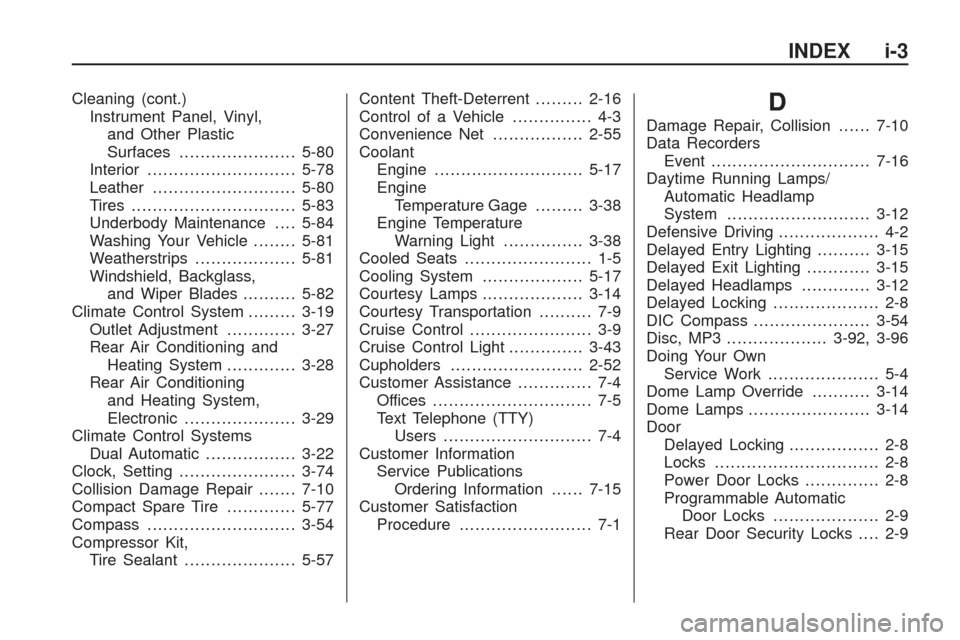
Cleaning (cont.)
Instrument Panel, Vinyl,
and Other Plastic
Surfaces......................5-80
Interior............................5-78
Leather...........................5-80
Tires...............................5-83
Underbody Maintenance....5-84
Washing Your Vehicle........5-81
Weatherstrips...................5-81
Windshield, Backglass,
and Wiper Blades..........5-82
Climate Control System.........3-19
Outlet Adjustment.............3-27
Rear Air Conditioning and
Heating System.............3-28
Rear Air Conditioning
and Heating System,
Electronic.....................3-29
Climate Control Systems
Dual Automatic.................3-22
Clock, Setting......................3-74
Collision Damage Repair.......7-10
Compact Spare Tire.............5-77
Compass............................3-54
Compressor Kit,
Tire Sealant.....................5-57Content Theft-Deterrent.........2-16
Control of a Vehicle............... 4-3
Convenience Net.................2-55
Coolant
Engine............................5-17
Engine
Temperature Gage.........3-38
Engine Temperature
Warning Light...............3-38
Cooled Seats........................ 1-5
Cooling System...................5-17
Courtesy Lamps...................3-14
Courtesy Transportation.......... 7-9
Cruise Control....................... 3-9
Cruise Control Light..............3-43
Cupholders.........................2-52
Customer Assistance.............. 7-4
Offices.............................. 7-5
Text Telephone (TTY)
Users............................ 7-4
Customer Information
Service Publications
Ordering Information......7-15
Customer Satisfaction
Procedure......................... 7-1
D
Damage Repair, Collision......7-10
Data Recorders
Event..............................7-16
Daytime Running Lamps/
Automatic Headlamp
System...........................3-12
Defensive Driving................... 4-2
Delayed Entry Lighting..........3-15
Delayed Exit Lighting............3-15
Delayed Headlamps.............3-12
Delayed Locking.................... 2-8
DIC Compass......................3-54
Disc, MP3...................3-92, 3-96
Doing Your Own
Service Work..................... 5-4
Dome Lamp Override...........3-14
Dome Lamps .......................3-14
Door
Delayed Locking................. 2-8
Locks............................... 2-8
Power Door Locks.............. 2-8
Programmable Automatic
Door Locks.................... 2-9
Rear Door Security Locks.... 2-9
INDEX i-3
Page 414 of 422

Driver
Seat Height Adjuster........... 1-3
Driver Information
Center (DIC)....................3-44
DIC Operation and
Displays...............3-45, 3-51
DIC Vehicle
Customization...............3-65
DIC Warnings and
Messages....................3-56
Driving
At Night..........................4-10
Before a Long Trip............4-12
Defensive.......................... 4-2
Drunk............................... 4-2
Highway Hypnosis............4-13
Hill and Mountain Roads....4-13
In Rain and on
Wet Roads...................4-11
Loss of Control................4-10
Off-Road Recovery............. 4-9
Rocking Your Vehicle to
Get it Out ....................4-16
Winter.............................4-14
Driving for Better Fuel
Economy........................... 4-1Dual Automatic Climate
Control System.................3-22
DVD
Rear Seat Entertainment
System......................3-114
E
EDR ..................................7-16
Electrical Equipment
Add-On Equipment............5-86
Electrical System
Fuses and Circuit
Breakers......................5-86
Instrument Panel
Fuse Block...................5-86
Power Windows and Other
Power Options..............5-86
Underhood Fuse Block......5-88
Windshield Wiper Fuses....5-86
Electronic Immobilizer
PASS-Key
®III+................2-18
Electronic Immobilizer
Operation
PASS-Key
®III+................2-18Engine
Air Cleaner/Filter...............5-15
Check and Service Engine
Soon Lamp..................3-39
Compartment Overview......5-10
Coolant...........................5-17
Coolant Heater.................2-23
Coolant
Temperature Gage.........3-38
Coolant Temperature
Warning Light...............3-38
Cooling System................5-17
Drive Belt Routing.............6-15
Exhaust...........................2-30
Oil ..................................5-11
Oil Life System.................5-13
Overheated Protection
Operating Mode............5-23
Overheating.....................5-22
Starting...........................2-22
Entry Lighting......................3-14
Event Data Recorders..........7-16
Extender, Safety Belt............1-27
Exterior Lamps....................3-11
i-4 INDEX